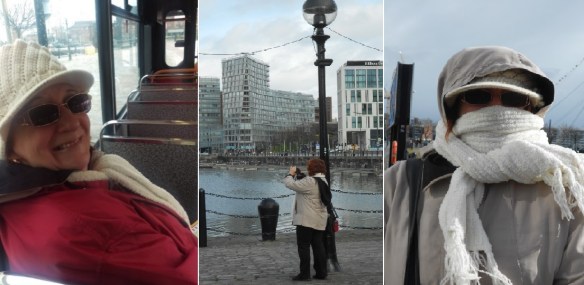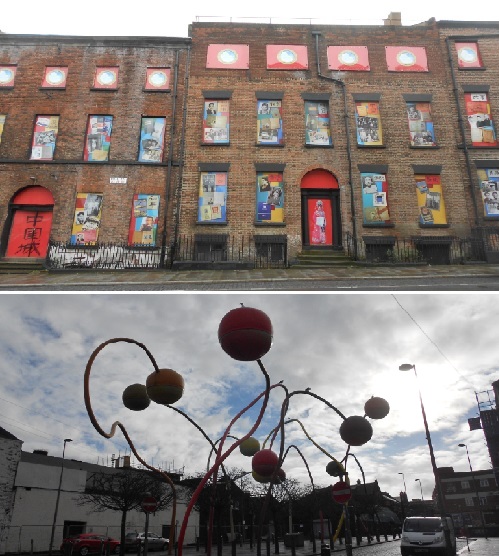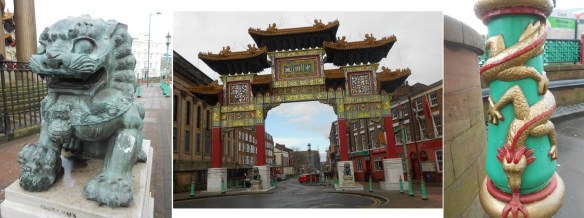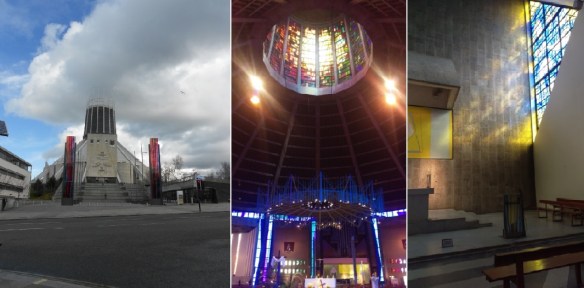The story so far…
Mum and I went to Liverpool over the Easter break. On Day 1 we did a Magical Mystery Tour, took the Ferry Across the Mersey, trawled through The Beatles Story and sweated it out at the Cavern Club. It was an excellent and very musically-themed beginning to our trip but there was much more to come. Here’s what happened next.
On Day 2, we started out with a City Explorer Bus Ride to orient ourselves with the other things to see and do in Liverpool. Our guide on the bus had a traditional Liverpudlian accent which Mum mentioned was sometimes hard to understand. Speaking of Mum here she is on the bus, taking photos (a common sight when one travels with my mother) and her version of rugging up against the blustery cold wind.

We then spent some time wandering around Albert Dock, taking more photos…


Top: The three graces of Liverpool Bottom: View from Albert Dock
…and visiting the International Slavery Museum.

We spent a couple of hours here. It was a great follow up to the Sugar and Slavery walking tour that I did in London in March and I must say that I left not only shocked by the legacy of the slave trade from the 15th and 16th centuries but devastated that slavery continues to prosper in places like India and Africa (just to name two).
We topped off our more leisurely day with a nanna nap back at the hotel before a fab dinner just around the corner at Jamie’s Italian (complete with a friendly waiter who had just returned from travelling in Australia).
Our final day dawned and with a mid-afternoon departure scheduled, we decided to spend our remaining time exploring on foot with a view to visiting Liverpool’s two cathedrals en route.
The streets behind the hotel yielded some interesting ‘art’…

…but we did find our way to Chinatown…

…before heading to our first place of worship, the gothic-inspired Liverpool Cathedral.

It was magnificent, full of soaring arches and stained glass. I particularly loved the intimacy and quiet of the Lady Chapel and the series of windows dedicated to some of the important women in English history…

After a fortifying coffee in the cathedral cafe, where we gazed out over the nave spotted with coloured light from the windows, it was time to head up Hope Street…

…to the Liverpool Metropolitan Cathedral.

This is the seat of the Archbishop of Liverpool and while it may not have the same traditional look as its Anglican counterpart at the other end of Hope Street, Paddy’s Wigwam (as it is also known) is Grade II listed. Originally the cathedral was to be the largest in Europe, planned to be on a par with St Peter’s Basilica in Vatican City but after several years and millions of pounds invested, only the crypt was completed and work stopped as the money dried up.
However, it was generally acknowledged that Liverpool still needed a cathedral and so Frederick Gibberd, winner of a world-wide design competition, built the existing cathedral between 1962 and 1967. He managed to do this within both the time period specified (five years) and the one million pound budget as well as preserving the crypt which is now used for all sorts of events and concerts.
After I got over my shock at its modernity, the space and light really grew on me and after wandering through the crypt as well, I left feeling more inspired by this unconventional tribute to faith than the traditional magnificence of the Anglican Cathedral at the bottom of the hill.
There was not much time left to explore so we headed back to the hotel to collect our things and made our way to Lime Street Station to catch our train back to London – just in time! But here are a few of the other places we saw on our final foray through the streets of Liverpool…

Clockwise from top left: The Everyman Theatre stands at the top end of Hope Street opposite the Metropolitan Cathedral; The Monro Gastropub in Duke Street, a former merchant’s house built in 1765, was named in honour of the first passenger service scheduled between Liverpool and New York in 1817; St Luke’s Church was built in the early 1800s and was badly damaged in the Liverpool Blitz of 1941 – the ruins are Grade II listed; the Philharmonic Pub on Hope Street, another Grade II listed building, was built for local brewer Robert Cain at the end of the 19th century.
And so that, my friends, was our Merseyside mosey. Liverpool turned out to be a great city with plenty to see and do so I hope you enjoyed the armchair tour.




